Audi Q2 VS Renault Trafic Bus – Specs, Efficiency & Price Comparison
Which model is the better choice – the Audi Q2 or the Renault Trafic Bus? We compare performance (300 HP vs 150 HP), boot capacity (405 L vs ), efficiency (4.80 L vs 6.80 L), and of course, the price (24900 £ vs 38200 £).
Find out now which car fits your needs better!
The Audi Q2 (SUV) is powered by a Petrol or Diesel engine and comes with a Manuel or Automatic transmission. In comparison, the Renault Trafic Bus (Bus) features a Diesel engine and a Manuel gearbox.
When it comes to boot capacity, the Audi Q2 offers 405 L, while the Renault Trafic Bus provides – depending on what matters most to you. If you’re looking for more power, you’ll need to decide whether the 300 HP of the Audi Q2 or the 150 HP of the Renault Trafic Bus suits your needs better.
There are also differences in efficiency: 4.80 L vs 6.80 L. In terms of price, the Audi Q2 starts at 24900 £, while the Renault Trafic Bus is available from 38200 £.
Compare all the key specs now and find out which model fits your lifestyle best!
Audi Q2
The Audi Q2 captures attention with its bold and distinctive design, combining compact dimensions with a sporty silhouette. Inside, the cabin boasts high-quality materials and a modern infotainment system, ensuring a comfortable driving experience. With its agile handling and efficient performance, the Q2 is a perfect urban companion for those seeking both style and functionality.
details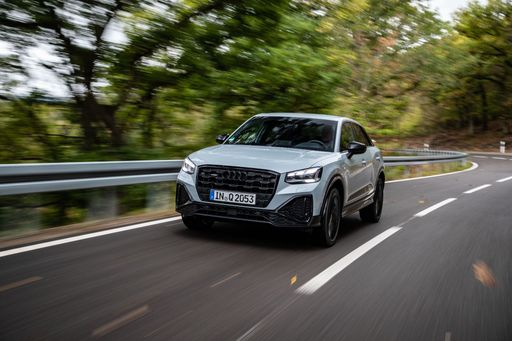 @ audi-mediacenter.com
@ audi-mediacenter.com
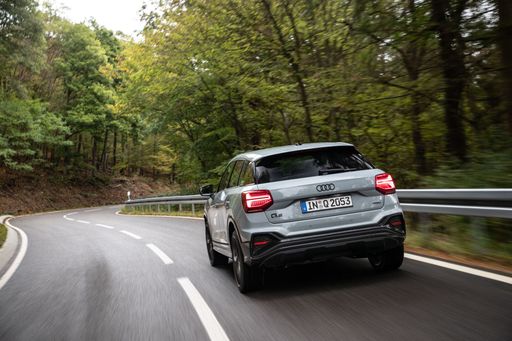 @ audi-mediacenter.com
@ audi-mediacenter.com
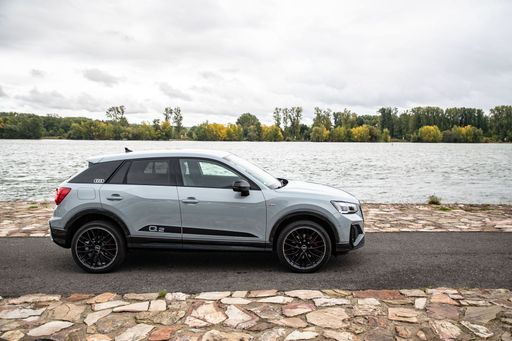 @ audi-mediacenter.com
@ audi-mediacenter.com
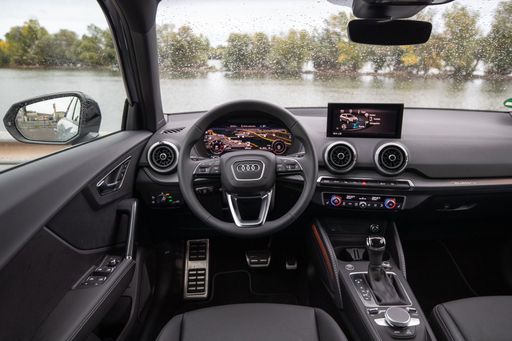 @ audi-mediacenter.com
@ audi-mediacenter.com
 @ audi-mediacenter.com
@ audi-mediacenter.com
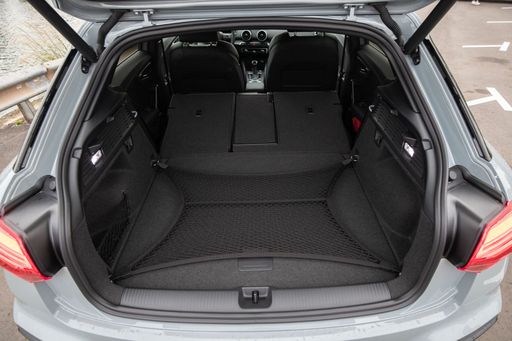 @ audi-mediacenter.com
@ audi-mediacenter.com
Renault Trafic Bus
The Renault Trafic Bus is a versatile and spacious option for those needing to transport multiple passengers comfortably. With its modern design and practical features, it is well-suited for both business and leisure purposes. Its efficient engine and smooth handling make it a reliable choice for long journeys.
details

|
|
|
|
|
Costs and Consumption |
|
|---|---|
|
Price
24900 - 43600 £
|
Price
38200 - 51100 £
|
|
Consumption L/100km
4.8 - 8.4 L
|
Consumption L/100km
6.8 - 7.2 L
|
|
Consumption kWh/100km
-
|
Consumption kWh/100km
-
|
|
Electric Range
-
|
Electric Range
-
|
|
Battery Capacity
-
|
Battery Capacity
-
|
|
co2
127 - 190 g/km
|
co2
179 - 188 g/km
|
|
Fuel tank capacity
50 - 55 L
|
Fuel tank capacity
80 L
|
Dimensions and Body |
|
|---|---|
|
Body Type
SUV
|
Body Type
Bus
|
|
Seats
5
|
Seats
8 - 9
|
|
Doors
5
|
Doors
4
|
|
Curb weight
1330 - 1610 kg
|
Curb weight
2031 - 2321 kg
|
|
Trunk capacity
355 - 405 L
|
Trunk capacity
-
|
|
Length
4208 - 4216 mm
|
Length
5080 - 5480 mm
|
|
Width
1794 - 1802 mm
|
Width
1956 mm
|
|
Height
1495 - 1508 mm
|
Height
1973 - 1974 mm
|
|
Payload
450 - 510 kg
|
Payload
749 - 982 kg
|
Engine and Performance |
|
|---|---|
|
Engine Type
Petrol, Diesel
|
Engine Type
Diesel
|
|
Transmission
Manuel, Automatic
|
Transmission
Manuel
|
|
Transmission Detail
Schaltgetriebe, Automat. Schaltgetriebe (Doppelkupplung)
|
Transmission Detail
Schaltgetriebe
|
|
Drive Type
Front-Wheel Drive, All-Wheel Drive
|
Drive Type
Front-Wheel Drive
|
|
Power HP
116 - 300 HP
|
Power HP
110 - 150 HP
|
|
Acceleration 0-100km/h
4.9 - 10.5 s
|
Acceleration 0-100km/h
13.6 - 16.5 s
|
|
Max Speed
197 - 250 km/h
|
Max Speed
161 - 174 km/h
|
|
Torque
200 - 400 Nm
|
Torque
300 - 350 Nm
|
|
Number of Cylinders
3 - 4
|
Number of Cylinders
4
|
|
Power kW
85 - 221 kW
|
Power kW
81 - 110 kW
|
|
Engine capacity
999 - 1984 cm3
|
Engine capacity
1997 cm3
|
General |
|
|---|---|
|
Model Year
2024
|
Model Year
2023 - 2024
|
|
CO2 Efficiency Class
D, E, F, G
|
CO2 Efficiency Class
G
|
|
Brand
Audi
|
Brand
Renault
|
Audi Q2
The Audi Q2 demonstrates a perfect blend of compact dimensions and luxury features, making it a prominent choice in the competitive SUV segment. With an attractive exterior design, high-quality interiors, and cutting-edge technology, it stands out as a versatile vehicle for urban commuters and weekend adventurers alike.
Striking Design and Practicality
The Q2’s design is a clear reflection of Audi's sophisticated aesthetics. Its bold stance is accentuated by angular lines and a distinctive Singleframe grille. Measuring between 4208 mm and 4216 mm in length, it remains compact yet offers ample interior space for passengers and cargo alike. The rear boasts a hatchback design, contributing to a practical trunk capacity of 355 to 405 litres, perfectly suited for everyday tasks.
Engine Options and Performance
Audi caters to diverse customer preferences by offering a range of engine choices, from efficient petrol units to powerful diesels. Engine power ranges from 116 to 300 PS, ensuring lively performance, while the 0-100 km/h acceleration time varies between 4.9 and 10.5 seconds, depending on the variant. The model year 2024 continues to impress with its harmonic balance of performance and economy, with fuel consumption figures ranging from 5.1 to 8.4 L/100 km.
Advanced Transmission and Drive Technologies
The Q2 is available with both manual and automatic transmissions, including Audi’s sophisticated S tronic dual-clutch system. Front-wheel drive and all-wheel drive options offer flexibility for different driving conditions, ensuring exceptional grip and stability on the road. With available torque figures from 200 to 400 Nm, the Q2 responds adeptly to driver commands, providing a dynamic driving experience.
Cutting-Edge Technology and Interior Features
Inside the Q2, the focus on quality is evident, with premium materials and clean lines that create a refined atmosphere. The multimedia interface features the latest in connectivity, including smartphone integration and a user-friendly interface. Optional upgrades such as the Virtual Cockpit and advanced driver assistance systems further enhance both comfort and safety, ensuring a worry-free driving experience.
Efficiency and Eco-Friendliness
Environmental considerations are integrated into the Audi Q2’s design, with CO2 emissions ranging from 130 to 190 g/km, depending on the chosen engine. The Q2 is available in several equipment lines such as ‘advanced’ and ‘S line’, allowing buyers to personalise their vehicle while taking advantage of the brand's commitment to sustainability. Fuel efficiency is balanced without compromising performance, confirming Audi's dedication to eco-friendly driving.
Conclusion: The Ideal Compact SUV
In summary, the Audi Q2 successfully embodies the perfect compact SUV, making it suitable for a variety of lifestyles. Its combination of distinctive design, flexible performance options, cutting-edge technology, and emphasis on efficiency make it a compelling choice for those seeking a premium vehicle that stands out on the roads and in the city.
Renault Trafic Bus
A Glimpse into the Renault Trafic Bus: An Icon of Versatility and Innovation
Amongst the plethora of vans designed for both business and leisure, the Renault Trafic Bus stands out as an exemplar of functionality, innovation, and style. Let's delve into what makes the Renault Trafic Bus a popular choice in the UK and across Europe, particularly focusing on its technical specifications and state-of-the-art features.
Performance Dynamics: Power Under the Hood
The Renault Trafic Bus, a staple in Renault's fleet, is driven by a robust diesel engine configuration with power outputs ranging from 110 PS to a formidable 170 PS. The diesel engines combine efficiency and power, offering torque figures between 300 to 380 Nm, ensuring smooth power delivery and capable load hauling.
Drivers can choose between manual and automatic transmissions, both designed to complement the Trafic's front-wheel-drive system. This flexibility ensures that drivers experience enhanced driving comfort whether they are navigating urban roads or cruising on the motorway.
Efficiency Meets Economy
The Trafic Bus showcases impressive fuel economy with consumption figures ranging from 6.8 to 7.2 litres per 100 kilometres. This efficiency is crucial for businesses aiming to minimise operational costs and for families seeking budget-friendly travel options.
With a generous fuel tank capacity of 80 litres, the Renault Trafic Bus is built to cover long distances with fewer fuel stops, making it an ideal choice for long haul journeys.
Technological Innovations and Comfort
The Trafic Bus isn't just about robust performance. Renault has integrated a suite of technological innovations designed to enhance driver and passenger comfort. Its cabins are equipped with the latest infotainment systems and safety technologies, providing an optimal blend of comfort and convenience.
The various trims, such as Life, Start, Spaceclass, and their respective EDC variants, cater to different needs and preferences, ensuring that customers can find the perfect configuration for their requirements.
Design and Dimensions: Space for Every Purpose
Space and versatility are at the heart of the Trafic Bus design. With its dimensions ranging from a length of 5080 to 5480 mm, and a width of 1956 mm, this vehicle offers ample room for passengers and cargo alike. The height stands between 1973 and 1974 mm, ensuring that even taller individuals can travel comfortably.
With seating for up to eight people and a payload capacity between 730 to 1010 kg, the Trafic Bus can transform seamlessly between a people-mover and a goods carrier.
Environmental Considerations
Renault has engineered the Trafic Bus with environmental responsibility in mind. The CO2 emissions range from 178 to 190 g/km, which, while modest for its class, aligns with the efficiency and performance goals set for this versatile vehicle. The CO2 efficiency class is rated as 'G', offering transparency in its environmental impact profile.
Conclusion: A Leader in Its Class
The Renault Trafic Bus continues to lead its segment through a blend of power, efficiency, and technological advancements. Whether it's for commercial transport or family adventures, the Trafic offers a reliable and adaptable solution, setting a high standard for multi-purpose vehicles.
For those seeking a distinguished blend of utility and comfort, the Renault Trafic Bus emerges as an exceptional choice, promising performance and innovation on every journey.
The prices and data displayed are estimates based on German list prices and may vary by country. This information is not legally binding.
